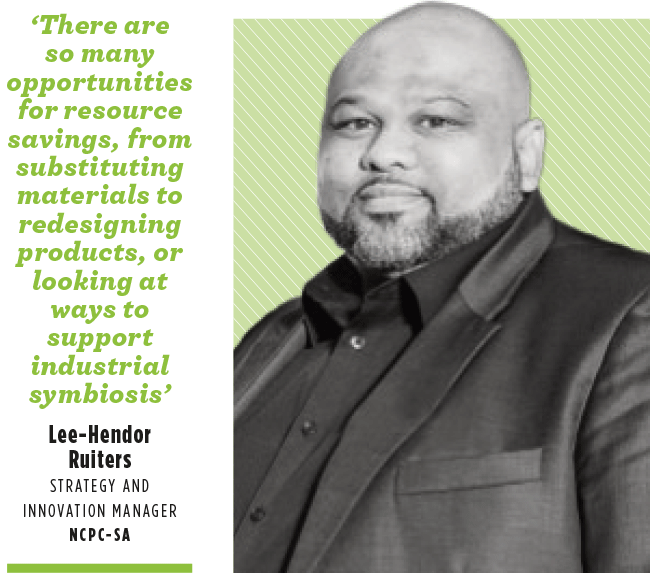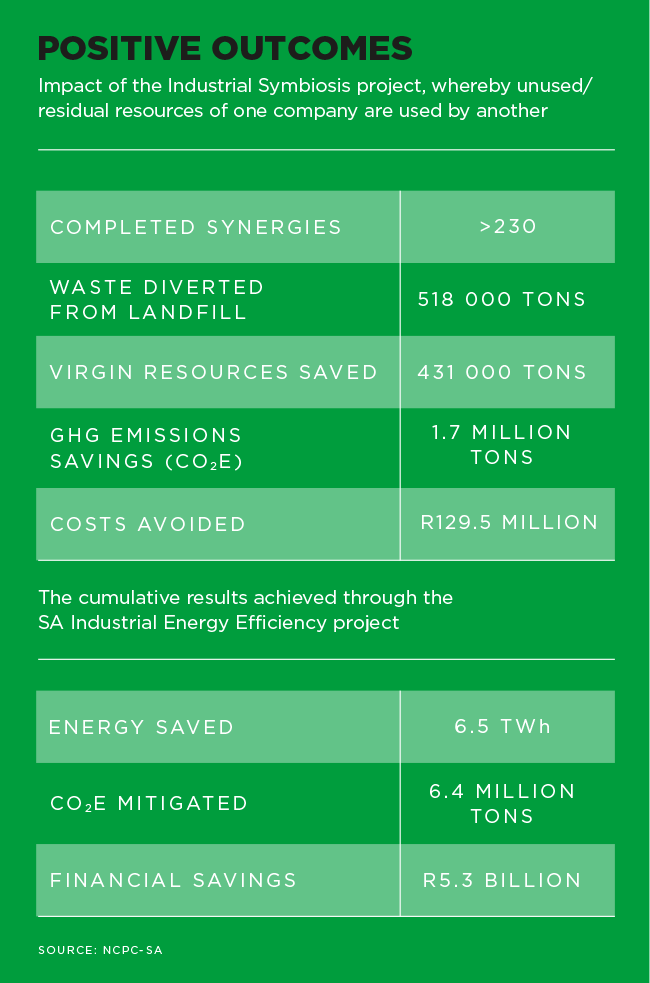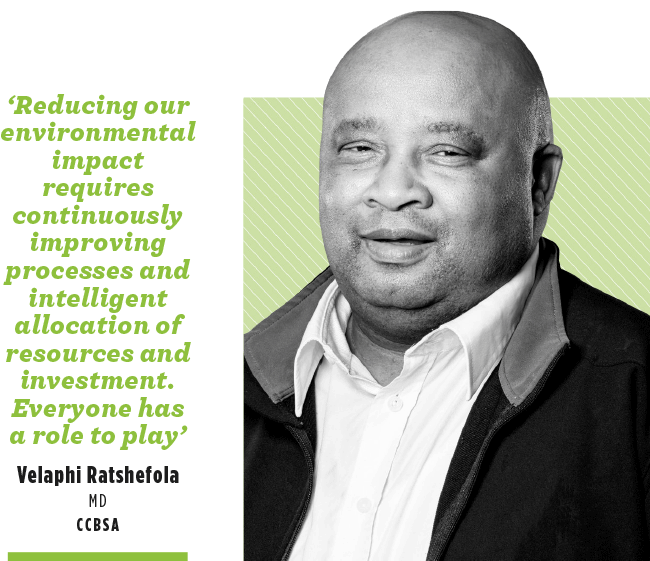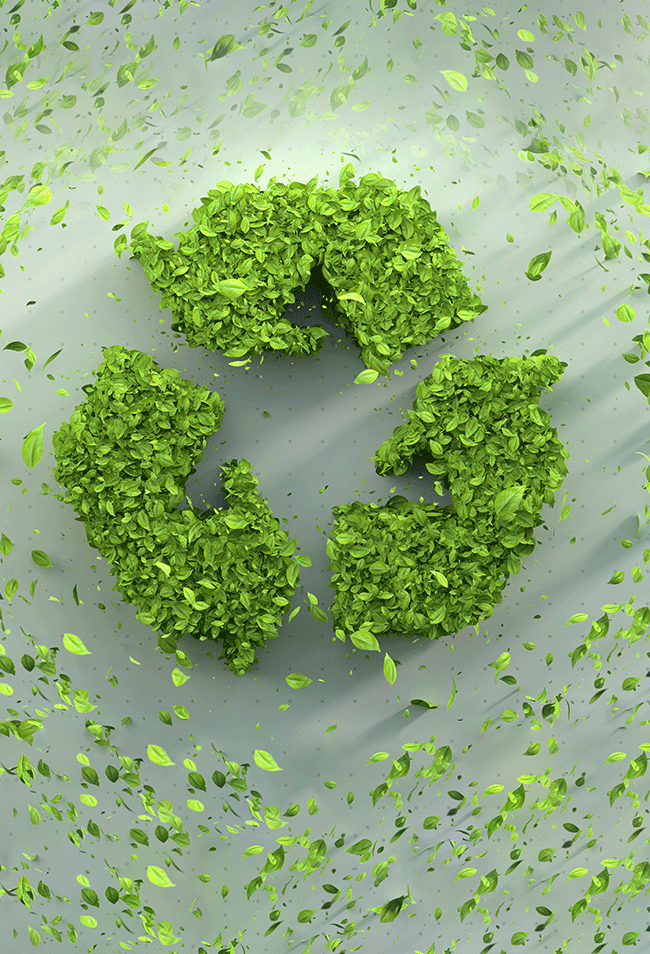While SA may be contending with its greatest challenges since the end of apartheid – namely the energy crisis, financial greylisting and political instability – it still stands shoulder to shoulder with developed nations in some important regards – one of those being that SA has achieved recycling rates higher than the global average for years, and this looks set to improve with the recent introduction of Extended Producer Responsibility regulations. Yet recycling is just one facet of the sustainability project. The manufacturing industry is also coming under increasing pressure to reduce the amount of materials used in their manufacturing processes – as well as water, energy and carbon emissions – without relying solely on recycling to reduce waste.
‘There’s been a shift, definitely – or, perhaps more accurately, a broadening of focus – from recycling and waste management, to material efficiency,’ according to Lee-Hendor Ruiters, strategy and innovation manager at the National Cleaner Production Centre South Africa (NCPC-SA), a subsidised government programme that offers various services aimed at ‘greening’ SA’s manufacturing industry.
‘Manufacturers are now looking at ways to reduce waste through better design of their products and manufacturing processes,’ he says. ‘One major misconception is that it’s prohibitively expensive. Local companies look at the expense of some US and European companies’ overhaul of their manufacturing processes, and it seems out of reach.
‘But there are so many opportunities for resource savings, from substituting materials to redesigning products, or looking at ways to support industrial symbiosis; this is where the waste product of one industry can become the material resources of another. For those who may need to invest in more resource-efficient machinery or equipment, green financing applications, usually from international funders, is something we also facilitate.’

The NCPC-SA has facilitated interventions for many large and small manufacturers – including Sappi, Unilever, Mr Price, Toyota Boshoku, Tiger Brands and AfriSam – since its inception in 2010, and conducts roughly 80 to 100 audits and produces five to 10 industrial resource-efficiency tools each year.
The NCPC-SA falls under the CSIR, which in August last year announced that it now hosts Africa’s only laboratory equipped to test and verify imported or locally produced products that are being promoted as biodegradable. This follows the Japanese government’s recent handover to the CSIR of an automated testing facility and equipment to the value of R5 million, through the UN’s Industrial Development Organisation. The testing laboratory is capable of establishing the conditions and time frames for the biodegradation of materials, and has been lauded as a step towards stemming the tide of plastic pollution.
Indeed, the CSIR has also developed a bioplastic technology for producing 100% biodegradable and compostable plastic. It enables single-use plastic products that, when they end up in landfills, biodegrade within 180 days.
The bioplastic products, when combined with organic waste, can turn into compost within 90 days, leaving no toxic residue. Pilot-scale testing has been carried out to produce the plastic (in the form of pellets) and an industrial-scale conversion process has been done for a specific product line, says CSIR senior researcher Sudhakar Muniyasamy, and the CSIR is now working towards licensing the technology.
While plastic-waste reduction remains an urgent goal in the fight against environmental degradation, water use, too, has come under the spotlight in SA’s manufacturing industry.

‘South Africa is a water-scarce country, contrary to what many believe’ says Velaphi Ratshefola, MD of Coca-Cola Beverages South Africa (CCBSA). ‘Therefore, we have a responsibility to use water as respectfully and efficiently as possible.
‘We’re continuously looking for innovative ways to reduce water use in our operations and collaborating with like-minded stakeholders to find long-term solutions that will safeguard this finite resource. Across all our facilities, we conduct thorough assessments of local water resources and put water protection plans in place so our presence doesn’t harm communities’ vital water resources.’ This forms part of Coca-Cola’s global World Without Waste vision, introduced in 2018. ‘We’re using a science-based approach to set clear targets and actions to significantly innovate how we manufacture our products and run our business,’ says Ratshefola. ‘Globally, the Coca-Cola company has set ambitious targets to reduce the amount of water needed to make its products. The CCBSA is currently tracking well ahead of global targets by using less water per one litre of product we manufacture. This is achieved through water-efficiency initiatives and technologies, and through reusing wastewater in other parts of our business operations. Our target is 100% replenishment of all the water we use in our drinks by 2030.
‘Reducing our environmental impact requires continuously improving processes and intelligent allocation of resources and investment. Everyone has a role to play in the manufacturing industry, using more efficient and less harmful process. We are leaders in using water responsibly in our operations and giving it back to communities, particularly indigent ones. As part of the world’s leading beverage company, we take the UN Sustainable Development Goal 6 – which talks to availability and sustainable management of water and sanitation for all – very seriously, and recognise global compacts signed by our country.’

The World Without Waste initiative also includes a commitment to help collect a bottle or can for every single one sold by 2030, to use 50% recycled content in all packaging and make 25% of its packaging reusable by the same year, while making all packaging 100% recyclable by 2025.
‘This is an ambitious target, but we are up for the task,’ says Ratshefola. ‘Among other measures, so far we have redesigned some of our packaging and launched an innovative refillable PET bottle that we can use numerous times, for as long as the bottle passes our strict quality test. What’s important is that consumers are part of this value chain and that they also benefit financially by returning the bottle for a deposit.’
In the Cape Town area, many manufacturers adopted more water-efficient practices due to the threat of Day Zero in 2017, after years of drought threatened the city’s water supply. While, thankfully, the drought broke, many have retained their water-wise practices, including Levi Strauss & Co’s manufacturing plant in Epping.
Denim (or, more specifically, cotton) manufacturing is one of the most water intensive in the textile manufacturing industry. An overhaul of the facility’s water-use infrastructure included the drilling of a borehole and the installation of a water-treatment plant, reducing their dependency on fresh drinking water for operations. Additional more efficient water-finishing techniques reduced the plant’s water use in manufacturing by 25%.
Likewise, other apparel brands are finding ways to integrate recycled materials and materials with a lower carbon footprint into their products. Nike has introduced several new materials into its various footwear and sportswear ranges that bring significant carbon savings. Nike Flyknit is a lightweight fabric with an average of 60% less waste than in traditional footwear-upper manufacturing; all Nike Air soles are composed of at least 50% recycled manufacturing waste; and Nike Forward is an all-new material made from ultra-thin, needle-punched layers (Forbes reports that the manufacturing process creates fibres from recycled plastic flakes and attaches them together using needle-punching machines mostly found in the automotive and medical industries).

According to the US Environmental Protection Agency, the global cement manufacturing industry is the third-largest industrial source of pollution, emitting more than 500 000 tons per year of sulphur dioxide, nitrogen oxide and carbon monoxide – about 8% of man-made carbon emissions.
Local cement manufacturer AfriSam has been a leader in reducing carbon emissions for more than two decades, with a wide range of augmentations to its manufacturing process, including the installation of emission-measuring equipment and the reduction of clinker content in its composite cements. With these and other measures still in place, AfriSam has managed, over that time, to reduce its emissions (about 598 kg of CO2 per ton of cement, according to Engineering News) to well below the global average of 642 kg of CO2 per ton.
Perhaps one of the biggest motivators for the ‘greening’ of local industries is that, unless SA manufacturers comply with increasingly stringent environmental regulations, their export opportunities may become extremely limited. City Press recently reported that thanks to the introduction of the EU’s Carbon Border Adjustment Mechanism (CBAM), R27 billion a year of SA exports are at risk.
The CBAM is a strategy for reaching the EU’s 2050 carbon emissions goal (a reduction of 55% by 2030). The agreement was endorsed by the European parliament’s Committee on Environment, Public Health and Food Safety in February 2023, but it still needs to be confirmed by ambassadors of the EU member states and the European parliament, and adopted by both institutions before its finalisation.
Increasingly, economic and environmental health are becoming intertwined in the global market; and while SA’s manufacturing industry can scarcely afford additional pressures at this time, the cost of ignoring its impact may prove to be too high. The world – and certainly the country’s – waste crisis calls for effective and ambitious solutions.








